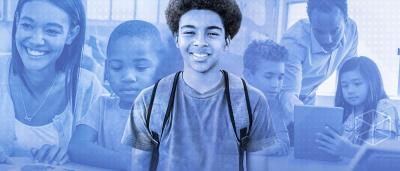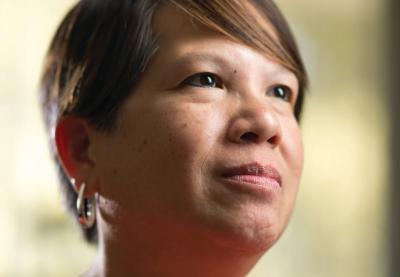In March of 2015, a second-grader approached teacher Miriam Santos-Amador while she was on lunch duty and asked her if she wanted to fight. She disengaged to discourage the question, yet the student continued, asking her repeatedly, “Wanna fight me?” Then—while her attention was elsewhere—he jumped onto a lunch table and slapped her in the face. Her own second-grade students stood in witness.
Santos-Amador is not alone. According to the Indicators of School Crime and Safety: 2014 report from the National Center for Education Statistics, over nine percent of school teachers were physically threatened or attacked during the 2011-2012 school year. Santos-Amador attributes the lunch-line incident to intertwining symptoms that underlie many of these assaults: trauma and a dearth of responsive psychological services in the school and community. Chronic poverty, for example, can erode many aspects of a student’s life and cause a host of complex symptoms. At La Esquela Fratney Elementary, where the incident occurred, many kids come to school without socks during the cold Wisconsin winters.
Santos-Amador knew this. She reasoned that the student must have interpreted something about her as threatening and attacked preemptively. But it didn’t make the experience any easier.
The assault Santos-Amador suffered is just one example of the traumas many teachers in the United States experience daily—some suddenly and others over extended periods.Trauma has many faces: the death of a student, a school closure, a bullying administrator or the stress of struggling to meet student needs that dwarf what the institution can provide.
Sociologist Paulle Bowen calls teaching in this kind of high-stress environment physically “toxic” because it presents real health risks and bodily dangers for educators.
Santos-Amador felt her own health decline after the assault. Her teaching suffered. Her class misbehaved for weeks. Feeling self-absorbed and guilty, she could not show up mentally for her students.
“I didn’t feel like teaching, or going to school, or doing anything,” she reports. “I felt invaded. He took with him my spirit to teach. I felt like I was trampled on in front of the whole school, and no one did anything to defend me.”
To help combat symptoms like those Santos-Amador experienced, a growing number of institutions—and individual teachers—are finding ways to promote resilience and physical and psychological healing from trauma. While some trauma-responsive interventions require deep institutional transformation, others are more personal.
Restorative Justice
Schools across the country have been turning to restorative justice practices as a way to reform their disciplinary policies. But restoring relationships can also promote resilience and healing throughout the larger school community—regardless of whether the individuals involved are adults or kids. Santos-Amador’s greatest difficulty in healing, she says, was an absence of restorative recourse. While a simple apology would have lifted her spirit, “He was never asked to say, ‘I’m sorry,’” she says. The student never understood he had done anything wrong.
A restorative circle is one example of a practice that explores difficult thoughts and emotions that victims and perpetrators experience during and after an incident, and asks how the harm can be repaired. Restorative circles emphasize reparative action rather than rules and consequences, and send a message that the feelings of all individuals matter.
At Greenway Elementary in Beaverton, Oregon, where Renee Caballero began the 2014 school year as a new principal, the school culture needed a boost. Seeking to build what she calls a “culture of hope,” she began implementing restorative practices—practices that improved the lives of teachers, too. Restorative justice is helping this community of educators to adopt a growth mindset and see that change is possible through fostering positive relationships throughout the building.
This year, Greenway teachers are learning how to facilitate restorative circles. “[The perpetrators] have to face the people they’ve harmed,” she reports. “We all [make] a plan and verbalize how we [will] support both the victims and the perpetrator.” Instead of sending kids home to play video games during a suspension (which Caballero admits is simpler), her staff will work with the school counselor to help students learn how their behavior impacts the whole community—including the teachers involved in the incident or initial referral.
Response to Trauma

At a more macro level, comprehensive programs such as University of California, San Francisco’s Healthy Environments and Response to Trauma in Schools (HEARTS) work to sensitize the entire school environment to the causes and effects of trauma. This includes supporting staff members who experience burnout. HEARTS trains educators on how trauma affects the brains of both students and teachers, and trains educators how to manage classrooms with chronically stressed students.
The HEARTS project is based on practices at the Trauma and Learning Policy Initiative in Massachusetts. The initiative’s program, Trauma Sensitive Schools, advocates for a “whole-school” approach and views teachers’ own well-being as fundamental to an institution’s success. “There is a cumulative impact on teachers of understanding what students are going through, and working with these students day in and day out,” says Joe Ristuccia, consultant for the initiative. Signs that a teacher is experiencing direct or vicarious trauma might include depression, developing a short temper, or compulsive shopping, drinking or eating.
The program uses its “flexible framework” to consult with schools, setting individualized priorities for change. It also teaches educator responsiveness to empathy fatigue. Initially, teachers learn self-awareness skills, becoming more attuned to early indicators of burnout. Next, the individual school staff members are trained to take responsibility for their symptoms. Trauma Sensitive Schools emphasizes the basics: conversation and connection with others. “Personal connection and community is ultimately where people turn to for resilience and for the support they need,” Ristuccia says. “We help remove the stigma and make it okay to talk about the impact.”
Mindfulness
Intervention for affected teachers also happens on an individual level. One study at the University of Vermont assessed the effectiveness of a program called Mindfulness Based Stress Reduction on educator stress and well-being. Over an eight-week period, participants learned body scanning, breathing awareness, yoga, and eating and walking meditation. In class, educators learned to nonjudgmentally become aware of their thoughts, feelings and sensations, to disengage from reactive patterns, and to become more resilient when faced with stressors.
Restorative justice is helping this community of educators to adopt a growth mindset and see that change is possible through fostering positive relationships throughout the building.
As the teachers developed their emotion-regulation skills, the study found they more effectively managed student behavior, de-escalated conflict, and built more positive relationships with their co-workers and students. Participants also slept better and demonstrated more self-kindness and compassion.
Linda Lantieri, founder of the Inner Resilience Program (IRP), puts this study into practice. Although the program was founded to help New York educators process the traumas of September 11, 2001, Lantieri says most teachers were chronically stressed before the attacks. Through contemplative practices like journaling, mindfulness, poetry and yoga, IRP workshops help teachers operating on overdrive to slow down, strengthening their capacity to respond calmly and creatively. As mindfulness increases, Lantieri finds, frustration drops and trust with students and colleagues builds.
Lantieri has seen educators incorporating the practices by encouraging staff meditations before school, creating contemplative peace corners in classrooms and conducting mindful walks with students in the hallways. At one school in East Harlem, Lantieri recounts, teachers were struggling with a high population of special-needs students. “They could barely get to 3 o'clock without doing something—not exactly unkind—but not as sensitive as they were at 9 o’clock in the morning,” she says. The teachers decided to gather in the staff room at lunch and listen to meditation tapes of mindfulness expert Jon Kabat-Zinn. Although they meditated together for just 10 minutes, the teachers reported feeling their best selves at the end of the school day.
Vicarious Resilience
Recent research has validated an old idea that teachers, medical professionals and social workers have noted anecdotally for years: vicarious resilience. Vicarious resilience describes the reality that those working in highly stressed or traumatized environments may actually experience positive outcomes, gaining improved skills to cope with and reframe negative events. Vicarious resilience develops and is nurtured within the heart of difficult experience.
In an online course for professionals working with trauma survivors, social work professor and trauma specialist Megan Berthold outlines several benefits of working in areas with high rates of trauma. These benefits include learning to overcome and transform traumatic experience, developing a deeper awareness of the broader socio-political context, and gaining a more realistic worldview. Berthold also describes improved self-esteem, increased empathy and compassion, and greater feelings of efficacy and commitment to one’s work. Citing psychologists David Engstrom, David Gangsei and Pilar Hernandez-Wolfe, she asserts that intentionally finding positive value in one’s work lowers the risk for empathy fatigue and burnout, initiating and sustaining a cycle of positivity and well-being.
Teachers can soon measure these findings against their own experiences. Hernandez-Wolfe is currently developing a vicarious resilience scale, where professionals working with trauma survivors can assess the positive impact of their work and track it over time. As educators assess their impact holistically, they develop trust in their vicarious resilience and build confidence in their growing efficacy as teachers.
Despite her assault, Santos-Amador found the resilience she needed to return to her classroom and teach her students. “I try to put it past me,” she says. “Every child needs another chance. Whatever happened yesterday is yesterday.” Resilience thrives through seeking a nourishing external community as well as replenishing one’s personal reservoir daily. Experts emphasize that compassion—for oneself, for students and for fellow educators—is a key reminder of the strength of human connection. With the right support, educators who breathe in suffering every day can learn to breathe out relief.
A Mindfulness Exercise That Has Helped Users for More Than 20 Years
Compassion is like a muscle: Without adequate training, it becomes fatigued. In high-stress professions such as teaching, an educator’s compassion muscle can become overworked to the point of atrophy, and eventually burn out. It is essential, therefore, for school staff members to exercise and build the muscle of compassion, allowing it to carry the weight of the many classroom stressors.
Practicing compassion is not difficult, but it does require intention. The best place to begin is with yourself, right where you are.
One way to get started is with a mindfulness tool, called RAIN, designed to help ground our experience in the present moment. RAIN is an acronym for recognize, allow, investigate, and not identify. Developed by Michele McDonald 20 years ago, this process helps us work with difficult emotions and accept reality as it is, without judgment. Through awareness and acceptance, compassion arises naturally. Practicing RAIN loosens the grip on our habit to control and disengage from present experience. It can be used anytime.
First, recognize what is happening now. Pause to notice sensations, thoughts, and feelings, rather than deny them or push them away. Some sensations may be pleasant or easy to engage with; others, such as anxiety or stress, may be more difficult to lean into. If a difficult experience arises, notice the accompanying physical sensations. Depression may come with a heavy, sunken feeling in the chest; anxiety may feel tight, with a fluttery sensation or shortness of breath.
Next, allow the moment to be as it is. See if you can listen with minimal judgment or control, opening to your subjective experience. If you notice resistance or dislike, allow that to exist as well. Making space for our difficulties can be healing in itself, as it cuts through the judgment or shame around “should.” Our habit to disengage can be tenacious, so it is important to practice allowing each moment in, again and again. With practice, this opening becomes more natural, and we begin to trade avoidance coping mechanisms for a healthy response.
If continuing feels right, we then investigate the sensations present. Investigating calls upon our natural curiosity, asking us to explore the feelings and go deeper. As we remain with our experience, we may begin to notice it changing. It may be helpful to label the sensation, noting silently to ourselves “anger,” “sleepiness” or “fear.” Going deeper into the feeling, we can explore its texture, shape or tone, labeling those features as we go. If we discover subconscious beliefs or judgments at play, it is important to note those too—without additional judgment. This inquiry can be painful, so it is crucial that you proceed with the same gentle kindness for yourself that you would give a good friend.
The last step is to not identify with the thoughts and sensations we have uncovered. By labeling our experience, we can recognize that the feelings arise, and eventually pass away, beyond our control. This intentional noting unhooks us from the feeling’s grip, reminding us that we are much more than this passing moment.
Over time, we become less fused with our experience arising of its own accord, and our compassion for ourselves grows. We begin to see our stories and beliefs for what they are, and open to a larger awareness of ourselves and our environment. This expanded awareness replenishes our natural desire to connect, to respond and to rest right where we are.

Check out this professional development resource to assess your fatigue levels and and your self-care needs.
